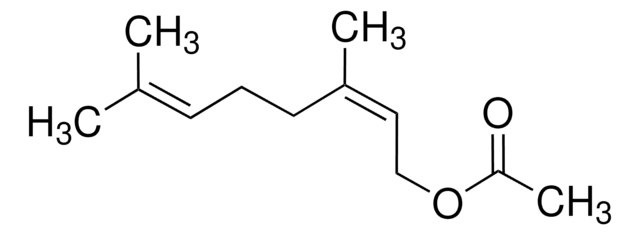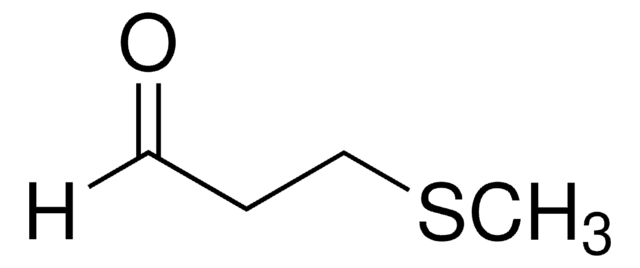W327506
Dimethyl trisulfide
≥98%, FG
Synonym(s):
2,3,4-trithiapentane, Methylsulfanyldisulfanylmethane
About This Item
Recommended Products
biological source
synthetic
Quality Level
grade
FG
Halal
Kosher
Agency
meets purity specifications of JECFA
reg. compliance
EU Regulation 1334/2008 & 178/2002
Assay
≥98%
refractive index
n20/D 1.602 (lit.)
bp
58 °C/15 mmHg (lit.)
mp
−68 °C (lit.)
density
1.202 g/mL at 25 °C (lit.)
application(s)
flavors and fragrances
Documentation
see Safety & Documentation for available documents
food allergen
no known allergens
Organoleptic
meaty; alliaceous; sulfurous
SMILES string
CSSSC
InChI
1S/C2H6S3/c1-3-5-4-2/h1-2H3
InChI key
YWHLKYXPLRWGSE-UHFFFAOYSA-N
Looking for similar products? Visit Product Comparison Guide
Related Categories
General description
Application
- Exploring the binding affinity and characteristics of DcitOBP9 in citrus psyllids.: This study investigates the binding properties of dimethyl trisulfide (DMTS) with DcitOBP9, an odorant-binding protein in citrus psyllids, providing insights into the potential role of DMTS in pest management strategies (Pei et al., 2024).
Signal Word
Warning
Hazard Statements
Precautionary Statements
Hazard Classifications
Acute Tox. 4 Oral - Eye Irrit. 2 - Flam. Liq. 3 - Skin Irrit. 2 - STOT SE 3
Target Organs
Respiratory system
Storage Class Code
3 - Flammable liquids
WGK
WGK 3
Flash Point(F)
132.8 °F - closed cup
Flash Point(C)
56 °C - closed cup
Personal Protective Equipment
Choose from one of the most recent versions:
Already Own This Product?
Find documentation for the products that you have recently purchased in the Document Library.
Customers Also Viewed
Our team of scientists has experience in all areas of research including Life Science, Material Science, Chemical Synthesis, Chromatography, Analytical and many others.
Contact Technical Service














